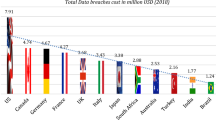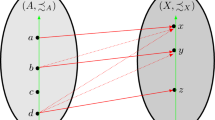Abstract
Transactional dependencies play an important role in coordinating and executing the subtransactions in advanced transaction processing models, such as, nested transactions and workflow transactions. Researchers have formalized the notion of transactional dependencies and have shown how various advanced transaction models can be expressed using different kinds of dependencies. Incorrect specification of dependencies can result in unpredictable behavior of the advanced transaction, which, in turn, can lead to unavailability of resources and information integrity problems. In this work, we focus on how to correctly specify dependencies in an advanced transaction. We enumerate the different kinds of dependencies that may be present in an advanced transaction and classify them into two broad categories: event ordering and event enforcement dependencies. Different event ordering and event enforcement dependencies in an advanced transaction often interact in subtle ways resulting in conflicts and redundancies. We describe the different types of conflicts that can arise due to the presence of multiple dependencies and describe how one can detect such conflicts. An advanced transaction may also contain redundant dependencies—these are dependencies that can be logically derived from other dependencies. We show how such extraneous dependencies can be eliminated to get an equivalent set of dependencies that has the same effect as the original set. Our dependency analysis is done in the context of a generalized advanced transaction model that is capable of expressing different kinds of advanced transactions.
Similar content being viewed by others
References
N.R. Adam, V. Atluri, and W.K. Huang, “Modeling and analysis of workflows using petri nets,” Journal of Intelligent Information Systems, vol. 10, no. 2, pp. 131–158, 1998.
G. Alonso, H. Kuno, F. Casati, and V. Machiraju, Web Services: Concepts, Architectures and Applications, Springer, 2003.
M. Ansari, L. Ness, M. Rusinkiewicz, and A. Sheth, “Using flexible transactions to support multi-system telecommunication applications,” in Proceeding of the 18th International Conference on Very Large Data Bases, Aug. 1992.
V. Atluri, W.-K. Huang, and E. Bertino, “An execution model for multilevel secure workflows,” in 11th IFIP Working Conference on Database Security and Database Security, XI: Status and Prospects, 1997, pp. 151–165.
P.C. Attie, M.P. Singh, A.P. Sheth, and M. Rusinkiewicz, “Specifying and enforcing intertask dependencies,” in Proceedings of the 19th International Conference on Very Large Data Bases, Morgan Kaufmann, Dublin, Ireland, Aug. 1993, pp. 134–145.
P.A. Bernstein, V. Hadzilacos, and N. Goodman, Concurrency Control and Recovery in Database Systems, Addison-Wesley, Reading, MA, 1987.
E. Bertino, G. Chiola, and L.V. Mancini, “Deadlock detection in the face of transaction and data dependencies,” in Proceedings of the 19th International Conference on Application and Theory of Petri Nets, vol. 1420 of Lecture Notes in Computer Science, Springer-Verlag, Lisbon, Portugal, June 1998, pp. 266–285.
A. Biliris, S. Dar, N. Gehani, H.V. Jagadish, and K. Ramamritham, “ASSET: A system for supporting extended transactions,” in Proceedings of ACM SIGMOD International Conferece on Management of Data, May 1994.
A.J. Bonner, “Workflows, transactions and datalog,” in Proceedings of the 18th SIGACT-SIGMOD-SIGART Symposium on Principles of Database Systems, Philadelphia, Pennsylvania, May 1999.
P.K. Chrysanthis, ACTA, A Framework for Modeling and Reasoning about Extended Transactions Models, Ph.D. Thesis, 1991.
P. Chrysanthis and K. Ramamritham, “ACTA: A framework for specifying and reasoning about transaction structure and behavior,” in Proceedings of the 1990 ACM SIGMOD International Conference on Management of Data, May 1990, pp. 194–203.
P.K. Chrysanthis and K. Ramamritham, “Synthesis of extended transaction models using ACTA,” ACM Transactions on Database Systems, vol. 19, pp. 450–491, Sept. 1994.
H. Davulcu, M. Kifer, C.R. Ramakrishnan, and I.V. Ramakrishnan, “Logic based modeling and analysis of workflows,” in Proceedings of the 17th SIGACT-SIGMOD-SIGART Symposium on Principles of Database Systems, Seattle, Washington, June 1998.
U. Dayal, M. Hsu, and R. Ladin, “Organizing long-running activities with triggers and transactions,” in Proceeding of the 17th International Conference on Very Large DataBases, Sept. 1991.
A.K. Elmagarmid, Database Transaction Models for Advanced Applications, Morgan Kaufmann, 1992.
R. Elmasri and S.B. Navathe, Fundamentals of Database Systems Systems, Addison-Wesley: Reading, MA, 4th edition, 2003.
X. Fu, T. Bultan, R. Hull, and J. Su, “Verification of vortex workflows,” in Proceedings of the International Conference on Tools and Algorithms for the Construction and Analysis of Systems, Genova, Italy, April 2001.
H. Garcia-Molina and K. Salem, “Sagas,” in Proceedings of ACM-SIGMOD International Conference on Management of Data, San Francisco, CA, 1987, pp. 249–259.
H. Garcia-Molina, J.D. Ullman, and J. Widom, Database Systems: The Complete Book, Prentice-Hall, 2002.
R. Gunthor, “Extended transaction processsing based on dependency rules,” in Proceedings of the 3rd International Workshop on Research Issues in Data Engineering: Interoperability in Multidatabase Systems, Vienna, Austria, April 1993, pp. 207–214.
G.T. Heineman, A Transaction Manager Component Supporting Extended Transaction Models, PhD Thesis, Columbia University, 1996.
J. Klein, “Advanced rule driven transaction management,” in Proceedings of the IEEE Computer Society International Conference, San Francisco, CA, 1991, pp. 568–573.
L.V. Mancini, I. Ray, S. Jajodia, and E. Bertino, “Flexible transaction dependencies in database systems,” Distributed and Parallel Databases, vol. 8, pp. 399–446, 2000.
J.E. Moss, Nested Transactions: An Approach to Reliable Distributed Computing, PhD Thesis 260, MIT, Cambridge, MA, 1981.
S. Mukherjee, H. Davulcu, M. Kifer, P. Senkul, and G. Yang, “Logic-based approaches to workflow modeling and verification,” in Logics for Emerging Applications of Databases, J. Chomicki R.V.D. Meyden and G. Saake (Eds.), Springer, 2004.
M.P. Papazoglou, “Web services and business transactions,” World Wide Web Journal, vol. 6, no. 1, pp. 49–91, 2003.
M. Prochazka, Extending Transactions in Enterprise JavaBeans, Tech. Report No. 2000/3, Dept. of SW Engineering, Charles University, Prague, 2000.
M. Robert, Event-Oriented Dynamic Adaption of Workflows: Model, Architecture and Implementation, PhD Disseration, University of Leipzig, 2003.
M. Rusinkiewicz and A.P. Sheth, “Specification and execution of transactional workflows,” in Modern Database Systems 1995, 1995, pp. 592–620.
M.P. Singh, “Semantical considerations on workflows: An algebra for intertask dependencies,” in Proceedings of the Fifth International Workshop on Database Programming Languages, Electronic Workshops in Computing, Springer, 1995.
J. Tang and J. Veijalainen, “Enforcing intertask dependencies in transactional workflows,” Research Report No. J-2/95. VTT Information Technology, Finland, 1995.
W.M.P. van der Aalst, “The application of petri-nets to workflow management,” The Journal of Circuits, Systems and Computers, vol. 1, no. 8, 1998.
H. Wächter and A. Reuter, “The conTract model,” in Database Transaction Models for Advanced Applications, A.K. Elmagarmid (Ed.), Morgan Kaufmann, 1992, pp. 219–263.
T. Xin and I. Ray, “Conflict detection of control flow dependencies in advanced transaction models,” in 9th International Database Engineering and Applications Symposium, Montreal, Canada, July 2005.
Author information
Authors and Affiliations
Corresponding author
Additional information
Recommended by: Amit Sheth
Rights and permissions
About this article
Cite this article
Ray, I., Xin, T. Analysis of dependencies in advanced transaction models. Distrib Parallel Databases 20, 5–27 (2006). https://doi.org/10.1007/s10619-006-8593-9
Published:
Issue Date:
DOI: https://doi.org/10.1007/s10619-006-8593-9




